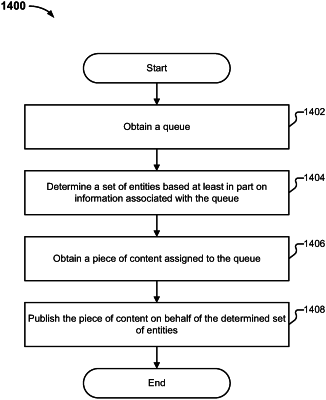| CPC H04L 51/52 (2022.05) [H04L 67/52 (2022.05); G06Q 50/01 (2013.01)] | 21 Claims |

|
1. A system, comprising:
one or more processors configured to:
obtain one or more pieces of content from a content database;
add the one or more pieces of content to a queue that is associated with one or more geographical regions, wherein content in the queue is to be published on behalf of entities determined to be in the one or more geographical regions, and wherein the one or more pieces of content are added to the queue at least in part by assigning, to the one or more pieces of content, a tag identifying the queue;
identify a set of entities that are in the one or more geographical regions associated with the queue;
schedule publishing of the one or more pieces of content on behalf of the set of entities at least in part by:
determining a distribution of the one or more pieces of content across the set of entities over a life of the one or more pieces of content; and
for at least two different entities on behalf of which content is to be published on a first portion of the life of the one or more pieces of content, assigning different content variants to the at least two different entities at least in part by assigning the different content variants to different queues, wherein the different content variants are collectively identified and handled as a single piece of content at least in part by associating the different content variants with a same parent content identifier; and
publish the different content variants on behalf of the at least two different entities for the first portion of the life of the one or more pieces of content; and
a memory coupled to the one or more processors and configured to provide the one or more processors with instructions.
|